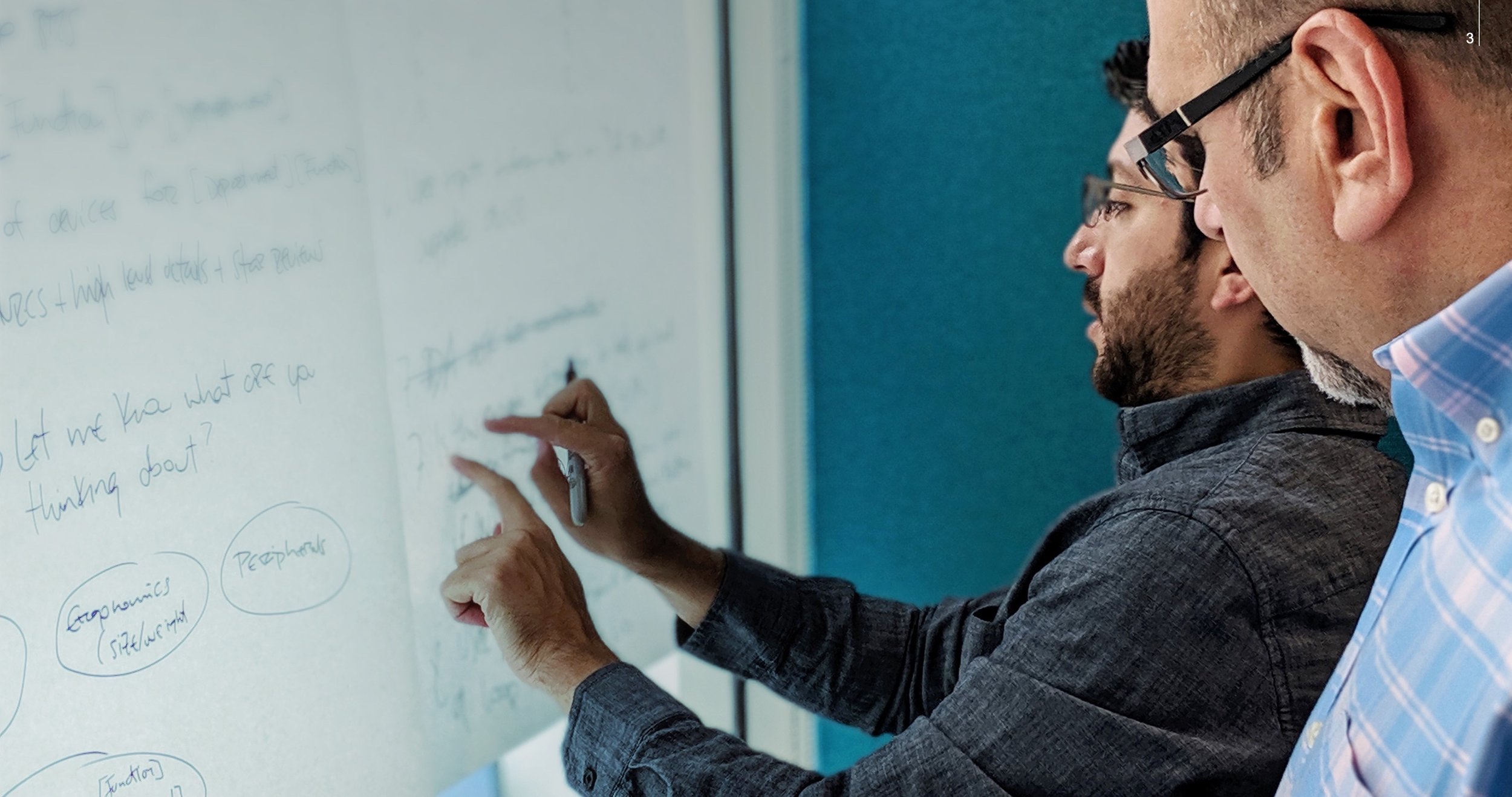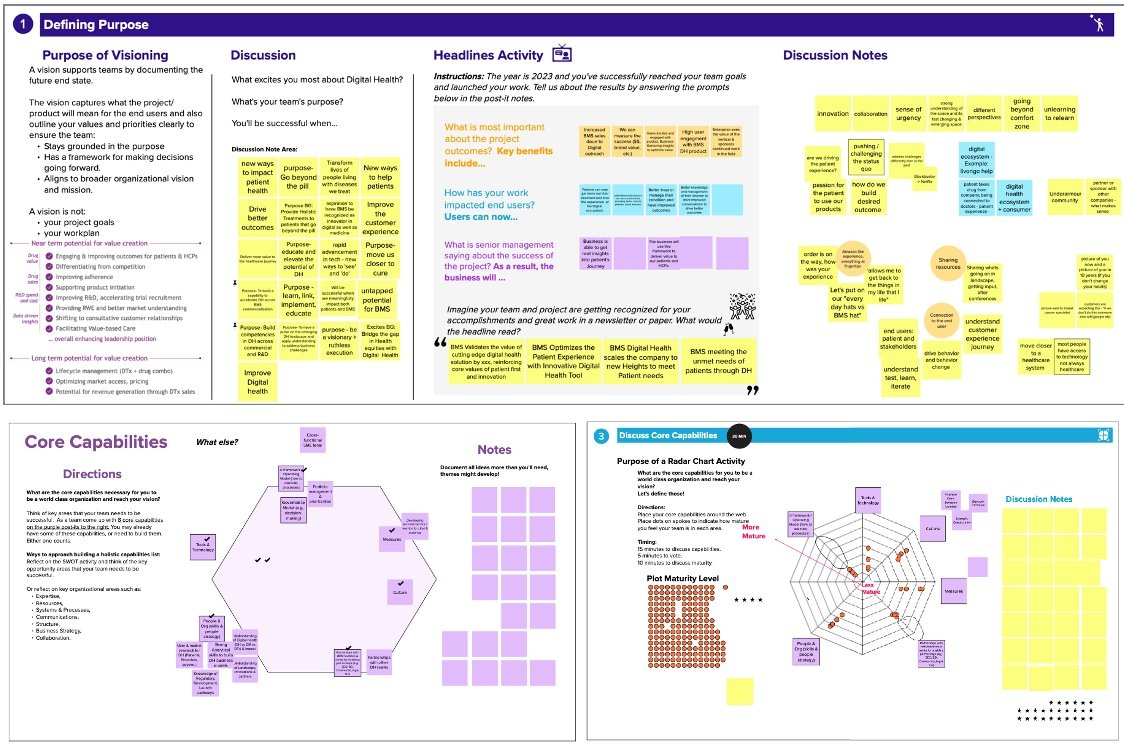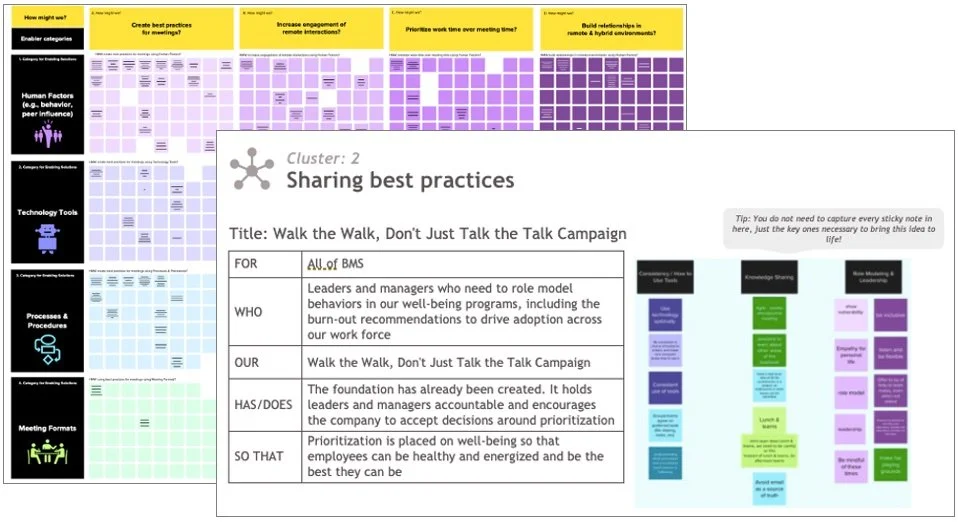
Design Thinking Center of Excellence
Embedded Strategy Program to Transform Culture at Scale
—
A global pharmaceutical company sought to infuse human-centered design and strategic practices into its’ IT organization to empower traditional thinkers with new approach to drive innovation.
A team from Smashing Ideas joined in a multi-year program to launch and run a Design Thinking Center of Excellence (CoE) and Community of Practice (CoP) for employees. Smashing partnered with teams across the organization to co-lead strategic projects and trained employees to facilitate Design Thinking activities through real world project experiences. Smashing formed, administered, promoted, and measured the program’s impacts for a 3-year period.
—
Outcomes
Program Launch & Administration – Successfully managed a 3-year global CoE program with embedded agency talent. Managed $1.5M yearly operating budget, maintained program roadmaps, and reported quarterly ORKs.
Strategy Projects – Chartered and led high-touch strategic projects across business groups from inception through execution to amplify the value of design and create human-centered solutions to business problems. Built cross-functional teams, scoped opportunities for embedded teams to innovated impactful solutions, exceeding resource cost-share target by +19% with 8.7 of 10 eNPS to recommended Design Thinking CoE.
Global Community of Practice – Directed the incubation of Design Thinking within IT and business partners to advance the adoption of human-centered design innovation practices. Expanded program reach to 62 global active community members engaged in project initiatives and monthly skills development.
—
My Contribution
Led program vision and strategy
Designed and administered program service offerings
Maintained program roadmaps, KPI development, tracking, and OKR reporting
Led project discovery and intake, and managed a staff of strategists through project execution
Served as Design Thinking SME, created repeatable design-sprints framework, wrote and published thought leadership
Embed innovation practices across the organization

Program Approach
Working in partnership with Smashing Ideas’ strategists, I led the formation of the program strategy and internal client engagement model to address organizational challenges and needs. As the program matured, I increased the program scope and scale by adding new capabilities and increasing our capacity to take on additional projects.
—
Year 1: Crawl
Program vision and strategy
Demand generation
Marketing and outreach
Pilot project
—
Year 2: Walk
Metrics development
Project pipeline and resource management
Launched Community of Practice
—
Year 3: Run
KPI reporting
Project pipeline and resource management
Standardize and harmonize work product
Training and mentorship program
Program Vision & Strategy
Worked in partnership with IT teams to form a comprehensive program vision and construct a hypothesis for how this program strategy achieves business objectives and fits the enterprise’s culture.
Audience definition to understand prospective customer goals, needs and pain points
Program purpose, potential risks and dependencies
Proposed measurement strategy to track program performance
Audience Personas
2-Year Roadmap & Resource Plan
Program Charter
Program Offerings
Engagement Model
Proposed Metrics
Program Service Offering Development
Design Thinking can be applied to a wide variety of challenges. To determine where Design Thinking could make a positive impact, I interviewed stakeholders, assessed past project performance, and identified opportunity areas where Design Thinking project interventions could lead to an improved outcome.
Program Audience & Differentiators
I facilitated collaborative sessions with the core project team to review the preliminary analysis from our interview findings.
Create assumptive target audience profiles
Review adjacent innovation practices
Project Ethnography
Reviewed past project approaches, mapped project journeys, and uncovered opportunities to incorporate research, iterative design, and audience testing activities into projects to overcome organizational challenges.
Map past project journeys
Deep analysis of past project activities
Service Offering Development
Generate lists of potential projects. Assessed their potential fit for Design Thinking. Form repeatable project offerings.
Identify potential Design Thinking interventions
Productize projects into repeatable springs
Launching Employee Learning Communities
I directed the creation of an employee learning program to increase opportunities for employees to acquire new skills, share knowledge, and grow their human-centered design practice to propel innovation within their project teams.
Community Engagement Strategy
Our team conducted interviews with employees identified by IT leadership as potential community members. We learned their background knowledge and use of innovation methods like Design thinking, Agile, and Lean, what they hoped to gain through their participation, and their desired level of community participation.
Community of Practice Membership Goals
Program goals were informed by employee feedback.
CoP Experience Service Blueprint
The service blueprint highlighted member acquisition, engagement, and retention strategies over time as our relationship with employee community members matured.
Marketing and Outreach
I directed monthly employee forums for sharing project experiences and lessons learned to inform the future direction of Design Thinking within the enterprise.
Community of Practice (CoP) Intranet
62 members worldwide
4-in-5 used Design Thinking on projects
Example of CoP advisory brainstorm broad
Design Thinking Training Sessions
I worked in partnership with a training expert to develop a remote educational experience facilitated by an instructor to introduce employees to Design Thinking, try it without the fear of failure, and generate opportunities to embed Design Thinking practices into employee project work.
Experiential Training
Average participants per session: 9
Largest group: 20
Prototyping Training Session
Program Measurement Strategy
The impact innovation programs generate cannot be measured as a single KPI. Our program tracked attitudinal, behavioral, and resource utilization metrics as leading indicators of the desired outcomes we hoped to achieve through exposure and participation in our program’s offerings. Lagging indicators, such as traditional business KPIs or creation of tangible business value, may occur years after a Design Thinking intervention, and could be partially attributed to the program’s influence.
We tracked the program reach across the organization, influence over time, and utilization of resource cost-sharing on projects.
The program experience was tracked through employee surveys to gain a pulse on the quality of our service offerings and delivery.
Business KPIs Dashboard
Program Experience Highlights
Project Opportunity Pipeline
Project Success Story
Strategic Projects
Design Thinking experts joined business groups to co-lead projects and guide stakeholders through the application of Design Thinking methodologies to advance high value strategic initiatives. As the program director, I oversaw project discovery and intake. I assessed and reframed projects to fit CoE mission and purpose. Over 3 years I directed the execution of a wide variety of projects and managed a team of strategists and design thinking experts through project execution.
Focus Areas
Area Assessment - Incorporation future-oriented perspectives into a business unit’s strategy
Identified ways to create human connection among distributed and remote workers
Rethought scientific lab work with a heightened need for collaboration and remote access
Initiative Design - Envisioning new initiatives to achieve organizational goals
Implemented community-driven stewardship of metadata to enable new research approaches
Reimagined how the Enterprise Architecture team should behave to inspire meaningful engagement early and often
Product & Service Innovation - Creation of digital products and service strategy to better address user needs
Uncovered the potential value of a Flow Cytometer “digital twin” to scientists
Provided UX and process improvement recommendations to make Biosamples more accessible to scientists across the enterprise
Repeatable Design Thinking Project Sprints
Over time, I created and shared a repeatable project playbook to onboarding new project practitioners more easily, transform project participants into advocates, set in motion change management to increase adoption of our solutions, and continually measure and improve the project experience.
Area Assessment Workshop
Led stakeholders through structured activities to gather diverse perspectives and align teams around a common goals.
Audience Needs Assessment
Gathered employee and customer perspectives through focus groups, interviews, and surveys to uncover unmet needs.
Research Synthesis
Mapped and clustered research datasets to identify new opportunities.
Project Vision
Formed strategy frameworks, drafted vision and mission statements, and guiding principles to guide team behaviors to achieve a desired outcome.
Experience Strategy
Created journey maps and personas to visualize experiences and identify opportunities to improving service delivery.
Ideation Sessions
Brainstormed strategies, objectives, and potential solutions with project stakeholders, sponsors, and end users.
Concept Testing
Designed and tested potential solutions with employee feedback validating solution desirability and potential organizational barriers to adoption.
Prioritization and Roadmap
Creation of roadmap of prioritized activities to guide project sponsor’s execution plan.
Project Playbook
While each project presents unique challenges, consistent inflection points provided opportunities to convey the value of Design Thinking to stakeholders, and gain organizational support to ensure the proposed solutions were implemented successfully.
Discovery
Project Experience Map
Shared with project teams to communicate the desired level of collaboration at each stage of the project.
Discovery Interview
Consistent question sets to gather baseline knowledge.
On-boarding
Opportunity Assessment
Scorecard to evaluate project value to the business and fit for Design Thinking.
Project Charter
A briefing document to frame project challenges and opportunities, and offer an approach.
Design Thinking Sprints
Retrospectives
Periodic meetings between project teams, stakeholders, and sponsors to continually improve the quality of delivery.
Off-boarding
Project Experience Questionnaire
Feedback form to gather input from project sponsors and stakeholders on their project experience and the anticipated impacts of our work.
Internal Marketing & Thought Leadership
Launched ongoing internal content marketing campaign to build awareness of the program objectives, attract interest in project partnership, and inspire employee to try Design Thinking practices with their teams. Tracked content engagement from Sharepoint and Yammer analytics.
Content Marketing
Promoted program service offerings
Published project success stories
Shared day-in-the-life practitioner experiences
Skills Building
Developed and shared how-to guides, downloadable templates with examples, best practices
Promoted training events




































